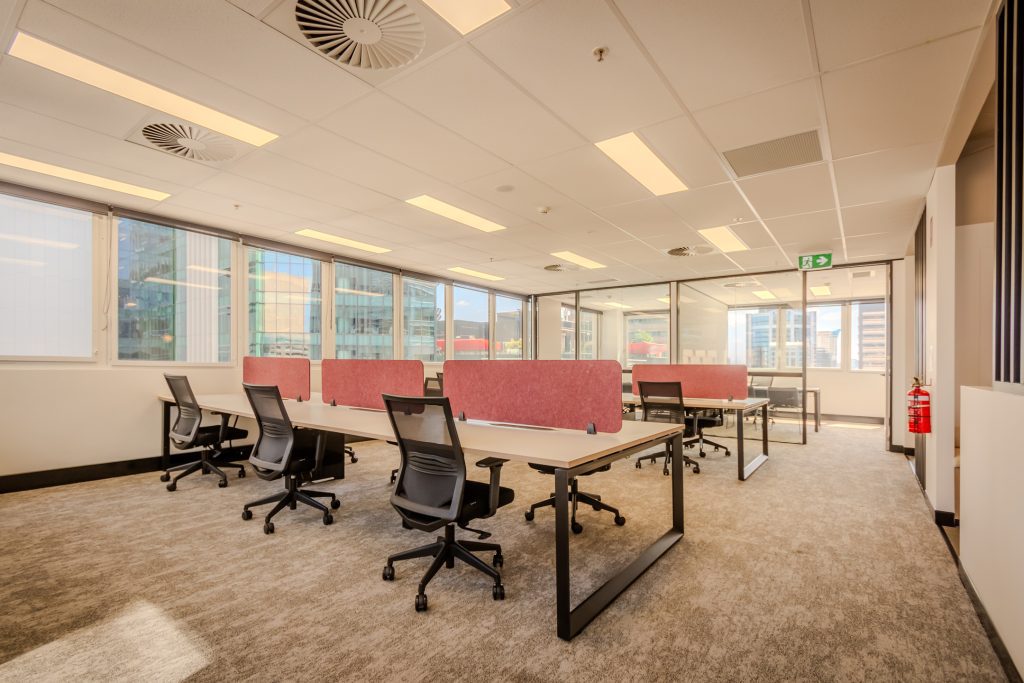4 Considerations For The End Of Your Office Lease
Your business’s lease is close to expiring – what are your options?


Fit out works done ‘on spec’ are by no means a new concept. Landlords have always looked at ways at repurposing existing fit outs within their buildings by making changes to the presentation and design in order to re-present fitted out space back to the market in a better light.
It makes commercial sense to do that. What we haven’t seen landlords do in the past, that we are seeing now, is build full fit outs (from scratch) with no prior commitment to the space from a tenant.
A speculative fit out, or ‘spec fit out’ as they are known within the office leasing space, are new fit outs constructed by landlords without any pre-commitment to the space by a prospective tenant.
The vacancy levels within the Brisbane office market have remained high over the last 12 years. The competition between building owners to secure new tenants has been fierce, and therefore landlords have been looking at different ways to present their space in order to give their properties an edge.
Newly fitted tenancy’s that are available on display, allows prospective tenants to ‘touch and feel’ what they are getting, which often gives them far more confidence to make a decision.
Spec suites first began to penetrate the Brisbane market in 2015/16 and had consistently grown their market presence until the spread of Covid-19 enforced the capital dry up in 2020.
Anecdotally, the period from around October 2020 to July 2021 saw a greater volume of investment in buildings’ common facilities – ground floor foyers, end of trips, lifts and the like – rather than direct investment in vacant suites.
With the new 2021-22 Financial Year also came a greater availability of capital and spec fit outs began to get underway again, resulting in a 72.2% increase in supply of spec fit outs from H1, ’21 to H2, ’21.
1. The risk around the cost and delivery of the fit out lies entirely with the landlord. The tenant has no liability whatsoever, which is attractive to many businesses.
2. There is no time expended by the tenant in having to work with designers to plan the layout and pick the finishes. For many business owners and/or senior managers this is one of the key benefits.
3. Quite often there is far more flexibility for the tenant around the term of the lease that they can take. Many businesses, particularly those that are still in their relative infancy, prefer lease terms of three (3) years as a maximum. For non-fitted space, it is not financially viable for a tenant to deliver a fit out themselves on anything less than a four (4) or five (5) year lease
4. Spec fit outs allow prospective tenants to move very quickly and easily, which can be a major benefit for a business, particularly if they are experiencing rapid growth, or are managing change within their business.
5. Tenancies with a spec fit out can often be far more financially attractive to an incoming tenant. Many landlords will offer additional incentives as rental abatement over and above the new fit out, even on lease terms as low as three (3) years. This is not achievable on non-fitted space.
6. Landlords and agents have now become very adept in partnering with designers to create amazing new office space environments. Most building owners have now rolled out multiple new fit outs within their properties and understand what finishes are most attractive to tenants. The competitive nature of the market place has driven a strong focus on quality, and owners have been cautious. This has been done by investing more heavily in their suites to ensure they have the very best chance of leasing.
7. Tenants that have leased a space with a spec fit out are not required to carry out a full ‘make good’ (strip out) at the end of the lease term. Requirements of a ‘make good’ are that the tenant returns the space to the landlord as they found it. This isn’t required with spec fit outs as the landlord paid for and owns the suite, so no strip out is needed.
1. Given the landlord is constructing the fit out ahead of any tenant commitment, whilst also owning the fitout for the duration of the lease, the landlord has full control of the fit out design. Therefore, some level of compromise on the tenant’s side in the terms of the layout is required, as it is not purpose-built to their requirements.
2. The tenant cannot be entirely sure about the quality of the fittings and finishes within the space, given the fit outs are often completed prior to any formal leasing campaign being undertaken. This risk can be partially mitigated by the tenant conducting sufficient due diligence with the fit out company that designed and managed construction of the suite/s.
3. Spec fit out office spaces are generally not completed to a point that a prospective tenant can walk in and start working. Most newly fitted out suites are not hard wired to the work-points and require additional power-points to be installed. Depending upon the specific needs of the tenant this can often cost between $800 – $1,000 per work-point.

Rents on spec fit outs have risen across the board with the exception of A Grade. This is partially tied to the 12 Creek Street Annex spec suites being leased in 2021 at grade topping rents, but these suites haven’t been replaced to the same quality, nor are subsequent suites within new developments.
In direct contrast to what many predicted through and post Covid-19, average lease terms on spec fit outs have gone up with 5+ year leases proving to be achievable (NB: 5 year leases with a break at 3 years are considered 5 year leases).
Tenants have recognised the opportunity to take a longer lease to extract the best possible deal terms at what could just about be the bottom of the market.
It’s interesting to see the highest incentives being offered on 1 – 2 year lease terms quite consistently. This can be attributed to the take up of suites which have sat vacant for an extended period of time and are subsequently leased at whatever terms can be achieved.
For this particular period, all specs leased on 1 – 2 year terms were vacant for over 12 months. Unsurprisingly we note an increase in incentives provided the longer a spec suite sits vacant.
Jumps are noticeable after 6-month increments where building owners become increasingly eager to get their suites leased. In contrast to this, we see that lease terms are actually likely to be shorter on spec suites that have been vacant for an extended period of time.
Again, this is a likely outcome of building owners becoming more motivated to shift their vacancies and will sacrifice on more facets than just incentives to attract an occupier.
Looking ahead, the future of the spec suite market is residing in larger spaces. As business growth and confidence continues to flourish, for what was once a sub-500sqm dominated section of the market, spec suites will be pushing the boundaries on size.
There has been a 22.67% increase in the size of specs landlords are building from 2021 to 2022 which we anticipate to only increase from here as full floor suites become more prominent.
Even though the price of construction costs has risen, it hasn’t gotten in the way of landlords building spec fit outs. Given this sudden rise in construction costs, owners have adapted by constructing a tranche of fit outs within the asset using an economies of scale approach. This in turn helps keep the price at a competitive level across the market.
Specs suites are becoming more prevalent by the day, for what was once a secondary grade asset dominated market has crawled its way up to Premium Grade landlords plugging holes with spec suites.
With all businesses looking for ways to reel tenants back into the office its anticipated that the spec suite market will only accelerate further with the Brisbane market being as competitive as ever.


Looking to contact the Caden Team? Get in touch by giving us a call or drop us an email.




Looking for one of our expert agents? Get in touch by giving us a call. Get access to all CBD offices with our team.



